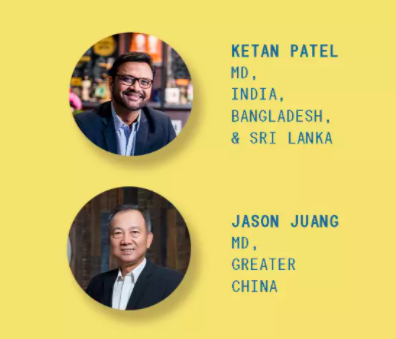Macrotrends and More: HP's Leaders on Asia's Future
A discussion with four of HP’s managing directors about the region’s megacities, sustainability, and the challenges and opportunities of the next decade.
Asia is already the continent with the largest GDP and population, concentrated in various megacities. The port of Shanghai, the financial might of Tokyo, and the service sector of Delhi are helping drive the world economy in the 21st century. These urban zones are promising beacons, but also face incredible challenges. The managing directors of Greater Asia; Greater China; Singapore and Malaysia; and India, Bangladesh, and Sri Lanka sit down for a roundtable discussion about the region’s future and HP’s role in it.
The five biggest cities in the world in 2030 are predicted to be Tokyo, Delhi, Shanghai, Mumbai, and Beijing. How are cities in your region meeting the post-pandemic challenges of the next decade?
Ketan Patel, MD of India, Bangladesh, and Sri Lanka: It’s not a coincidence that all five cities are in Asia and they face common issues. It took a pandemic to show us the importance of sustainable and healthy living environments. Delhi and Mumbai both have large infrastructure and environmental issues that can be addressed through technology that enables hybrid work and learning environments, thus helping reduce commutes and pollution; public Wi-Fi hotspots; EV transport policy; and more.
Tian Chong Ng (TC), MD of Greater Asia: We expect health tech to expand, accelerated by the pandemic but also the changing demographics in some countries. The over-65 population is soon expected to be one billion, and healthcare spending will increase in areas like telemedicine and health diagnostics where rapid, accurate testing is required.
Jason Juang, MD of Greater China: China’s 14th Five-Year Plan and its 2035 Vision both made sustainability a priority. The government promised to build sustainable and livable cities that will help achieve the goal of becoming carbon neutral. HP is involved with projects to improve the public transit of several cities.
Vivian Chua, MD of Singapore and Malaysia: The pandemic showed there was a digital divide that threatens productivity and growth. Singapore has to address both the need for a skilled, digitally ready workforce and having a high external trade dependence. Partnerships, collaboration, and professional development will be key to addressing these challenges.
Tell us about a trend or development you’ve witnessed that you would like to see adopted around the globe.
VC: The overnight shift to ecommerce in Singapore brought to light the need for digital transformation across many SMB industries, especially food and beverage, cleaning services, grocery deliveries, and vertical farming.
TC: Japan and Korea are accelerating the growth of AI and data science in edge computing. There are numerous established companies and startups that are pushing the boundaries of smart manufacturing, IoT, and deep learning in areas such as agriculture, healthcare, and fintech. The Korean government plans to expand smart factories from 100 in 2020 to more than 2,000 over the next 10 years, working with major corporations and universities.
JJ: While the pandemic and social distancing have accelerated cashless payments in America and Europe, China is a pioneer, propelled by Alibaba’s Alipay and Tencent’s WeChat Pay. In mid-2019, there were 633 million mobile payment users in China, and by 2023, it’s estimated that around 60% of China’s 1.3 billion population will have made a purchase via mobile payment.
KP: In the next five years, social commerce is expected to become a $16 billion industry in India. Add that to the fact that ecommerce and consumer goods companies are able to successfully deliver to the remotest regions here and this can create a platform that generates sales channels for local brands and jobs for micro-entrepreneurs.
Will the trend of remote worker migration, with workers moving to Tier 2 and Tier 3 cities where the cost of living is lower, affect megacities in your region?
JJ: Worker migration has already happened in China. Due to the high cost of living in the original Tier 1 cities (Beijing, Shanghai, Guangzhou, and Shenzhen), more workers, especially those with children, are relocating in search of better and less stressful living environments. This is driving the emergence of the “new” Tier 1 cities like Hangzhou, Chengdu, Nanjing, Wuhan, and others with their attractive environments, fast-growing economies, and lower property prices. These cities are introducing financial and housing policies to attract new talent, and consequently, many internet giants and big companies have opened offices.
KP: We saw a massive reverse migration of workers in India during the lockdown. However, with the gradual easing of restrictions and vaccines on the horizon, we have seen a sizable return of the workforce. Still, the ability to work from home, plus the lower costs of setting up a business, real estate, and hiring, plus the good amount of IT/ITeS sector presence, means Tier 2 and Tier 3 cities, which are already some of the fastest-growing cities in the region, and smaller towns will likely become hiring hot spots for white-collar jobs.
What are the top sustainable impact challenges facing your regions, and what is HP doing to help?
TC: We’ve run campaigns in Australia and New Zealand to highlight the dangers of ocean-bound plastics, and in Singapore, we conducted one of the largest e-waste recycling campaigns. In Indonesia, we partnered with Project STOP, which is aimed at reducing the volume of ocean-bound plastics while providing employment for low-income families. By December 2022, it is expected to expand to more than 450,000 people across 55 villages, with 90 tons of plastic bottles collected annually.
KP: While large organizations and well-funded educational institutes have been able to switch to digital, it has not been the same for many small businesses, workers, and students. Tech companies like HP can step in with tools and solutions that equip students, educators, and workers. The HP CLAP (Continued Learning Access Project) is a mobile van equipped with HP devices and learning content that visits underserved students in remote communities.
JJ: HP partnered with the WWF for the restoration, protection, and conservation of 200,000 acres of forest. Under this partnership, we will specifically work with the state-owned farms and forest plantations in China to enhance their capabilities of sustainable management. By collaborating with the WWF, HP is also working to increase the use of Forest Stewardship Council–certified paper.
How are you identifying opportunities over the next decade for HP customers in your region?
TC: We monitor the trends in our countries by talking to our customers and partners. Some countries, such as Japan and Korea, are at the forefront of 5G adoption, and we are able to apply what we learn from them to other countries. Australia and New Zealand have a significant focus on sustainability, and we are able to pick up future trends and best practices from them.
JJ: The digital boom has led to the fast growth of Chinese companies like Tencent, JD, and Alibaba. HP is a partner-first company, and we are partnering with these leading companies to build and evolve ecosystems. For example, HP and Alibaba Cloud have built an end-to-end classroom platform to promote the integration of online and offline teaching resources to meet China’s agenda on education information.
KP: In a country like India with low PC penetration, we are now seeing the shift from one PC per family to one per person. We have a strong ability to gain information from customers, channel partners, ecommerce players, and businesses, and are deploying digital tools to generate insights from this data to better our go-to-market and product strategies.
VC: We see tremendous opportunity in helping companies stay ahead of the curve. Across the government, manufacturing, financial services, healthcare, and education, digital transformation provides new growth possibilities, and we’re pursuing industry partnerships, driving our own initiatives like HP for Business, which offers device leasing for PCs and printers, and giving manufacturers faster access to 3D services and expertise.




